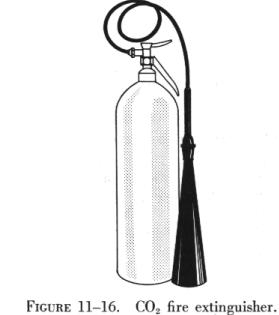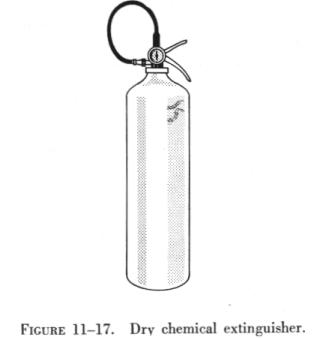AIRCRAFTFIRE
AIRCRAFT FIRE EXTINGUISHERS
Fire is one of the most dangerous threats to aircraft - either in flight
or on the ground. Airborne fixed, powerplant and airframe, detection and
extinguishing systems are designed and installed by the manufacturer in
compliance with applicable FARs. The requirement for portable fire extinguishers
installed in the crew and passenger compartment says, the extinguisher
must be approved, must be appropriate for the kind of fire likely to occur
and must minimize the hazard of toxic gases.
The National Fire Protection Association (NFPA) Standard #408, Aircraft
Hand Fire Extinguishers, suggests the type, capacity, location and quantity
of hand fire extinguishers for the protection of aircraft compartments
occupied by passengers and crew. This standard suggests carbon dioxide
and water (water solution) as the extinguishing media for hand type extinguishers.
Both type extinguishers are suggested for use in the passenger compartment,
the number of units being regulated by the number of passengers carried.
Carbon dioxide is suggested for the crew compartment. A halogenated hydrocarbon
extinguishing agent (Halon 1211 or Halon 1301) having an Underwriter's
Laboratory toxicity rating of 5 or higher may be substituted for the carbon
dioxide, if there is sufficient free air volume in the immediate area to
prevent serious irritating effects on the occupants.
The following extinguishing agents are not recommended for aircraft
use:
1. Dry chemical extinguishers are very effective in Class B and C fires
but they leave a residual dust or powder. This obstructs vision, is difficult
to clean up and causes damage to electronic equipment.
2. Carbon tetrachloride is no longer approved as a fire extinguishing
agent. It produces a poisonous gas (phosgene) when in contact with hot
metals. Soda acid and foam, these are toxic to a degree and can be corrosive
to adjacent materials.
3. Methyl bromide is more toxic than CO2 and cannot be used in confined
areas. It is also very corrosive to aluminum alloy, magnesium and zinc.
4. Chlorobromomethane, although an effective extinguishing agent, is
toxic.
| Extinguishers
The common aerosol can type extinguishers are definitely not acceptable
as airborne hand type extinguishers. In one instance, an aerosol type foam
extinguisher located in the pilot's seat back pocket exploded and tore
the upholstery from the seat. The interior of the aircraft was damaged
by the foam. This occurred when the aircraft was on the ground and the
outside temperature was 90° F. In addition to the danger from explosion,
the size is inadequate to combat even the smallest fire. In another instance,
a dry chemical extinguisher was mounted near a heater vent on the floor.
For an unknown reason, the position of the unit was reversed. This placed
the extinguisher directly in front of the heater vent. During flight, with
the heater in operation, the extinguisher became overheated and exploded
filling the compartment with dry chemical powder. The proximity of heater
vents should be considered when selecting a location for a hand fire extinguisher. |

|
 |
Additional information relative to airborne hand fire extinguishers
may be obtained from the local FAA District Office and from the National
Fire Protection Association, 470 Atlantic Ave., Boston, MA 02210.
Ground Type Extinguishers - Hand Type
The selection of a fire extinguisher for ground installation, shop,
fueling station, etc., is not restricted as it is for airborne installations.
The range of selection for agent and type extinguishers is shown in figure
11-11. (See figure 11-16 and figure 11-17).
Methods of Extinguisher Operation. The methods of operation of extinguishers
are most conveniently arranged by grouping extinguishers according to their
expelling means. Six methods are in common use. |
Selfgenerating - actuation causes gases to be generated that
provide expellent energy.
Selfexpelling - the agents have sufficient vapor pressure at
normal operating temperatures to expel themselves.
Gas cartridge or cylinder - expellent gas is confined in a separate
pressure vessel until an operator releases it to pressurize the extinguisher
shell.
Stored pressure - the extinguishing material and expellent gas
are kept in a single container.
Mechanically pumped - the operator provides expelling energy
by means of a pump and the vessel containing the agent is not pressurized.
Hand propelled - the material is applied with scoop, pail, or
bucket.
Several different extinguishing materials are handled by each of these
expelling means.
Discontinued Fire Extinguishers (see figure
11-14 and figure 11-15)
There are still in use today several million fire extinguishers of a
design no longer manufactured. These are the 1 1/2, 2 1/2 and 5 gallon
"invert to use" liquid extinguishers. The last of this type were manufactured
in the 2 1/2 gallon size. The agents used in these extinguishers are:
1. Soda-acid.
2. Foam.
3. Water cartridge.
4. Loaded stream cartridge.
The reasons which influenced the decision to discontinue manufacturing
these extinguishers are:
1. Invert to use - difficult and unorthodox method of activation.
2. Limited to the types of fires for which they are suitable. Mostly
Class "A" fires, very limited application of foam on Class "B" fires.
3. None approved for electrical fires.
4. Effective on only minimal size fires.
5. The container does not meet current pressure vessel standards. This
is the most significant of all.
Comparison of Safety Factors
Discontinued types of extinguishers use a shell rated at either 350
or 500 psi. However, when these extinguishers are inverted to operate,
the pressures generated often are unpredictable, totally unlike the pressures
in other extinguisher designs. Pressures may range from 100 to 300 psi
for soda acid extinguishers and from 100 to 350 psi for the foam extinguishers.

